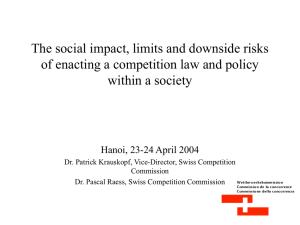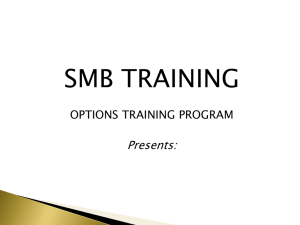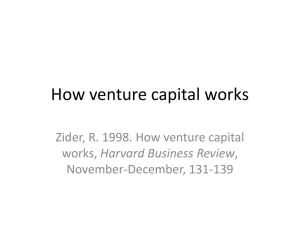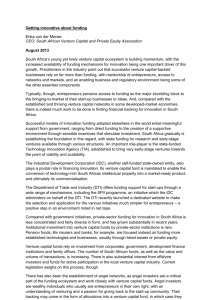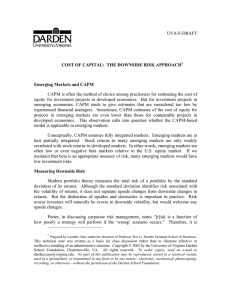Effectuation TechNote
advertisement
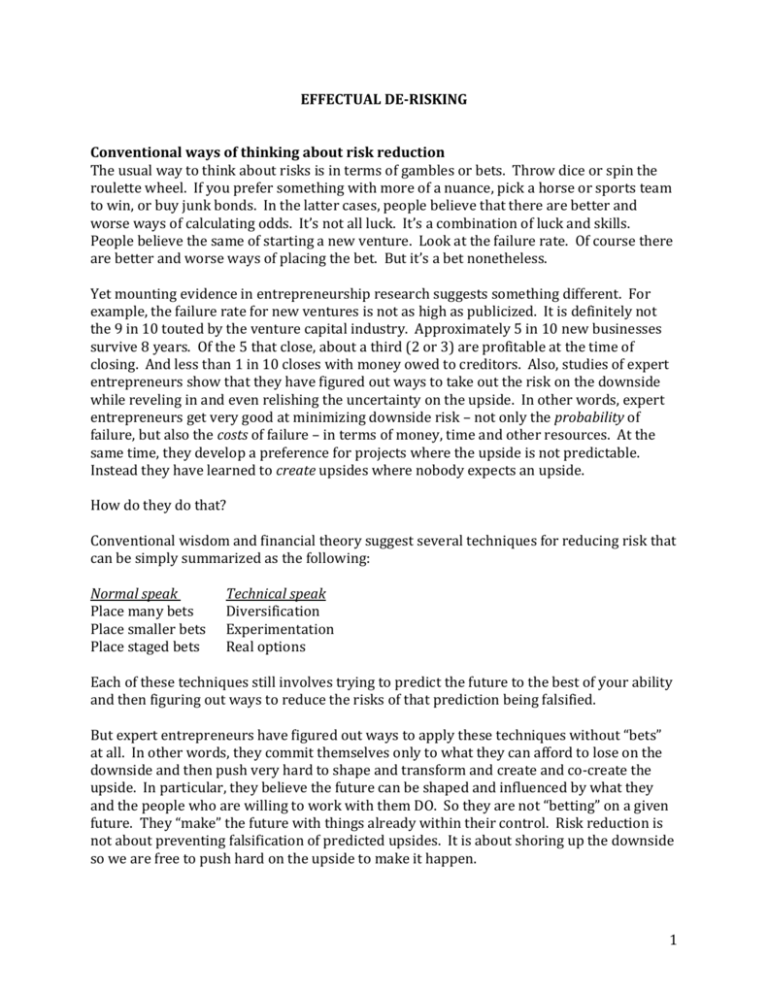
EFFECTUAL DE-RISKING Conventional ways of thinking about risk reduction The usual way to think about risks is in terms of gambles or bets. Throw dice or spin the roulette wheel. If you prefer something with more of a nuance, pick a horse or sports team to win, or buy junk bonds. In the latter cases, people believe that there are better and worse ways of calculating odds. It’s not all luck. It’s a combination of luck and skills. People believe the same of starting a new venture. Look at the failure rate. Of course there are better and worse ways of placing the bet. But it’s a bet nonetheless. Yet mounting evidence in entrepreneurship research suggests something different. For example, the failure rate for new ventures is not as high as publicized. It is definitely not the 9 in 10 touted by the venture capital industry. Approximately 5 in 10 new businesses survive 8 years. Of the 5 that close, about a third (2 or 3) are profitable at the time of closing. And less than 1 in 10 closes with money owed to creditors. Also, studies of expert entrepreneurs show that they have figured out ways to take out the risk on the downside while reveling in and even relishing the uncertainty on the upside. In other words, expert entrepreneurs get very good at minimizing downside risk – not only the probability of failure, but also the costs of failure – in terms of money, time and other resources. At the same time, they develop a preference for projects where the upside is not predictable. Instead they have learned to create upsides where nobody expects an upside. How do they do that? Conventional wisdom and financial theory suggest several techniques for reducing risk that can be simply summarized as the following: Normal speak Place many bets Place smaller bets Place staged bets Technical speak Diversification Experimentation Real options Each of these techniques still involves trying to predict the future to the best of your ability and then figuring out ways to reduce the risks of that prediction being falsified. But expert entrepreneurs have figured out ways to apply these techniques without “bets” at all. In other words, they commit themselves only to what they can afford to lose on the downside and then push very hard to shape and transform and create and co-create the upside. In particular, they believe the future can be shaped and influenced by what they and the people who are willing to work with them DO. So they are not “betting” on a given future. They “make” the future with things already within their control. Risk reduction is not about preventing falsification of predicted upsides. It is about shoring up the downside so we are free to push hard on the upside to make it happen. 1 Effectual De-risking: How expert entrepreneurs suggest you do it 5 principles of effectuation = 5 principles of de-risking Over a decade of studies into entrepreneurial expertise has brought to light five key principles expert entrepreneurs use to build new ventures. They are: Bird-in-hand: Begin with who you are, what you know and whom you know and not with some so-called opportunity “out there” for which you have neither the abilities nor the resources, nor even the contacts to make it happen. Affordable loss: Don’t invest more than you can afford to lose. Make your investment decisions based on understanding and shoring up the downside, not dreaming of or placing a bet on the upside. Crazy quilt: Work to co-create the future with people who want to work with you and commit to a shared future. Don’t worry about competition. Partner, partner, partner. Lemonade: Be prepared to turn on a dime when needed. Embrace surprises and creatively transform even negative feedback into useful inputs into your venture. Pilot-in-the-plane: Don’t worry about planning and predicting every aspect of your market. Roll up your sleeves and construct its components beginning with the doable and pushing outward through the people who come on board. Each of these principles can be used to de-risk your own venture in the following way: 1. List all risks you can imagine – both personal and venture/market-related. Brainstorm with friends and talk to experienced advisors in coming up with the list 2. Separate this list into downside risks and upside risks. Downside risks include the resources you are likely to lose if things don’t work out. They also include emotional and psychological risks associated with failure. (We will discuss each of these separately later) Upside risks include things such as customers may not buy, investors may not invest and so on. 3. Then shore up the downside before you begin pushing on the upside Shoring up the downside: Work with things already within your control Invest no more than you can afford to lose (See next for how to calculate your affordable loss) Note that each and every thing you need to build your venture is affordable loss for someone somewhere. We will tackle that under the “co-creation” section below. 2 Calculating your own affordable loss: Think through what you can afford to lose— in terms of time (I’m willing to work nights and weekends, or I am going to take six months between jobs), in terms of money (I can afford to take out a home equity loan or I just got this small inheritance that I am willing to invest in this), and in terms of other resources (I am going to call in a few favors owed to me, or I am simply going to build the prototype) Think through how much you are willing to lose for the particular project steps you are actually planning to take—half of the above amount, for example, so you can try two projects instead of one, in case the first one fails. Take those steps at those levels of investment if you feel comfortable that those steps are worth taking even if you lose all your investment—i.e., think through nonmonetary benefits. Think creatively about how you can reduce actual cash outflows on this investment—and continually strive to drive it close to zero. Reducing actual cash outflows: Don’t buy what you can rent or lease Don’t rent what you can borrow Don’t borrow what you can get for free Even with things you can get for free, see if you can do without Resource constraints make you creative and lead you to innovative solutions that become hard to imitate or duplicate, ESPECIALLY if they involve partners who want to co-create the future with you. Co-creating the future: One of the strongest and surest ways of reducing downside risk is to spread it among a growing network of self-selected stakeholders. Stakeholders are people who actually commit something real to you and to your venture. They put real skin in the game early on. Stakeholders may consist of: Customers willing to pre-order your products and services Suppliers and service providers (such as lawyers and accountants) willing to give you long and easy credit terms Investors willing to underwrite particular project steps Experienced people willing to provide advice and support with no immediate payment Employees willing to operate on vested options basis or even as unpaid volunteers in the initial stages People willing to call up other people and willing to “sell” on your behalf 3 Note that not all stakeholders come pre-labeled as “customers” or “suppliers” etc. In fact, avoid pre-labeling them at all. For example, your early customers should also be your early investors and salespeople. Your suppliers may also turn out to be investors and investors may be very good head-hunters for filling out your core team. And so on and so forth. In sum, note that committed stakeholders enable all three conventional de-risking strategies listed at the beginning of this note – namely, making your bets smaller, staged and more diversified. Yet when the stakeholders are effectual – i.e. they self-select into the process and invest no more than they can afford to lose -- they make their commitments without specific promises of a huge upside. Why would they do that? Because they have their own vision of how to shape your venture and construct your market. Listen to them and be open to pivot and change in ways that make both your and their visions of the future come true. Dealing with failure: Last, but not the least, note that working with things within your control, not investing more than you can afford to lose, co-creating the future with committed stakeholders and the willingness to pivot and change when needed, all lead to you not only flying the plane of your own future, but you becoming the designer and builder of planes no one, including you, ever dreamt of. But such magnificent possibilities do not happen without your willingness to look failure in the face ahead of time and get ready to outlive it and even build on it. Here are three maxims from expert entrepreneurs on dealing with failures: Keep ‘em small Kill ‘em young Don’t fail alone Understanding how to deal with failures involves understanding that the path to success (with a capital ‘S’) is paved with many failures and many successes, none of which should make or break you or your venture. Entrepreneurial expertise consists in (a) designing smaller failures that happen earlier and are shared with committed partners, (b) outliving them, and (c) continually pushing for, accumulating and growing small successes that are also pushed to happen earlier, and are shared with committed partners. So go ahead and start de-risking. Shore up the downside and become free to enjoy the uncertainties of the upside. Once you have shored up the downside and learned to partner with self-selected stakeholders, the upside can only be delightfully unexpected. Bon voyage! 4
